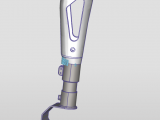Thanks to the advancement of artificial intelligence, today’s bionic mechanical devices can achieve most of the content that people need. The lower limbs are an important part of the human body structure, which not only ensures normal walking, but also plays the role of carrying weight. Therefore, the design of bionic mechanical devices for lower limbs must meet the requirements of stability, adaptability and flexibility.
In the past, in order to meet different prosthetic and knee function configurations, different design schemes were needed to evaluate the mechanical properties. Tradition is a test method that is not only long-term but also expensive. With the popularity of the finite element method, the structural design of the prosthesis has been gradually optimized, and the choice of materials has become increasingly diverse.
The main role of the prosthesis in daily use is load bearing, so the model can be simplified as appropriate, considering only the strength analysis of the structure under static force. Simright can easily implement the above functions. As an online cloud analysis software, you only need to import the model in the simulator, as shown in the figure below, and then submit the solution through simple setup, thus improving the design efficiency.

After the prosthetic model is introduced into the Simulator, the sole is directly in contact with the ground, so a fixed constraint is imposed on the sole of the foot; in addition, a surface load is applied to the bottom surface of the prosthesis to simulate human gravity. The material of the sheath part is selected from polyethylene plastic, and the supporting part is selected from the metal material. After dividing the grid, the solution is submitted, and the displacement cloud map and the stress cloud diagram are as follows.


It can be seen from the displacement cloud diagram that the displacement of other parts is larger except for the bottom support plate; it can be seen from the stress cloud diagram that the larger stress portion occurs mostly in the bent portion. Therefore, the supporting structural material should have good elasticity and certain requirements for the rigidity of the material. Both aspects should be fully considered in the design.
Click to view item


